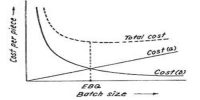Here describe outline the procedure to be followed in a modern factory for the purchase of raw materials till the payment of the bill therefor.
Each concern adopts its own procedure regarding the purchase of materials. Forms and records may differ slightly but the procedure is the same which is explained as follows:
(A) Indenting for Materials
Actually, the purchase procedure starts with the stores’ department. The stores’ department prepares indents for the purchase of materials and forwards the same to the purchasing department. Indents maybe classified into two categories: (1) regular indents and (2) special indents,
Regular indents:
- These indents are meant for replenishment of stocks.
- Regular indents are prepared periodically.
- They are placed when the ordering level for various items of stocks are reached.
- They must be certified by the stores’ department.
Special indents:
- Special indents are meant for a special job.
- They are prepared only when the necessity arises.
- Special indents are based on the demands received from respective departments (planning or production).
- These indents are to be certified by the department from where it gets originated.
(B) Issue of Tenders
It is the duty of the purchasing department to issue tenders to suppliers. In order to obtain quotations from prospective suppliers of goods and services, business organizations float tenders. A specific type of tender may be adopted for different types of tenders:
(i) Single tender: Enquiries are issued to one supplier only. It holds good for propriety items.
(ii) Open tender: In the case of a large number of goods with high value, this type is adopted. Usually, this type is published in leading newspapers and reputed trade journals.
(iii) Limited tender: Tenders are issued only to a limited number of suppliers chosen from the list of vendors.
(iv) Global tender: The firms advertise in international trade journals. This method is used when international financial institutions are involved and when the order value is high.
Tenders are prepared in triplicate. Two copies will be sent to the supplier. Of these two, one copy will be retained by the supplier, the other copy (usually original) will be sent by the supplier to the purchasing department by stating their terms and conditions of supply of goods or services. The third one is retained by the firm (purchase department).
(C) Receiving Quotations
When quotations are, received from suppliers, they have to be processed cautiously. A comparative statement is used. The prospective suppliers are to be ranked based on the prices quoted by them. Further, the following factors have to be considered while processing the tenders:
- The quality of goods
- Time to be taken for delivery
- Financial capability of the supplier
- The integrity of the supplier.
At the time, purchases may be made without inviting quotations. In such cases, the cost component and the price have to be taken into consideration for such cost-plus contract basis purchases.
(D) Placing Purchase Orders
After receiving and analyzing the tenders, the purchase order is to be prepared. The purchase order is prepared in six copies. They are routed to –
- accounts department,
- the supplier,
- purchase department,
- receiving department
- originating department, and
- Inspection department, one copy each.
In general, the order is issued to the supplier with has offered the lowest price and who has committed to supply the goods with required specification within the stipulated period.
The purchase order has legal and accounting significance. Legally, it binds both the parties in terms of a contract. From the accounting point of view, it envisages the store’s department to accept the goods and the accounts department to accept the bill.
(E) Inspecting Stores Received
After receipt of the goods, the stores’ department cheeks the goods (against the supplier’s delivery challan) with the purchase order. It is ascertained whether materials conform order in respect of description and quantity.
After this, materials are sent to the inspection department, where an inspection note is prepared. The material inspection note is a document which depicts the material code, description, and specifications, quantity received for inspection, quantity accepted, quantity rejected and reasons for rejection. An inspection note has to be prepared in four copies. One copy is sent to the store’s department, one copy is sent to the supplier, one to the purchasing department and one to the accounts department.
(F) Receiving Stores
After an inspection is completed, goods are sent back to the store’s department. At this stage, the store’s department prepares a stores receipt note or goods received a note. It shows the materials received from suppliers. This is a document which shows the material code, description, specifications, quantity, unit price and value of materials. After issuing stores receipt note (goods received note), the storekeeper is responsible for stocks. This is a document for the posting of receipts in bin card and stores ledger. The store’s note is circulated to the production planning and control department, accounts department, inspection department and the costing department.
(G) Passing Bills for Payment
Bills sent by suppliers were received first by the purchasing department. Then they are forwarded to the stores accounting section. They check the authenticity regarding quantity and price and its arithmetical accuracy. Other special items shown in the bill like packaging and forwarding charges are verified with the purchase order. The bill is finally passed for payment.














